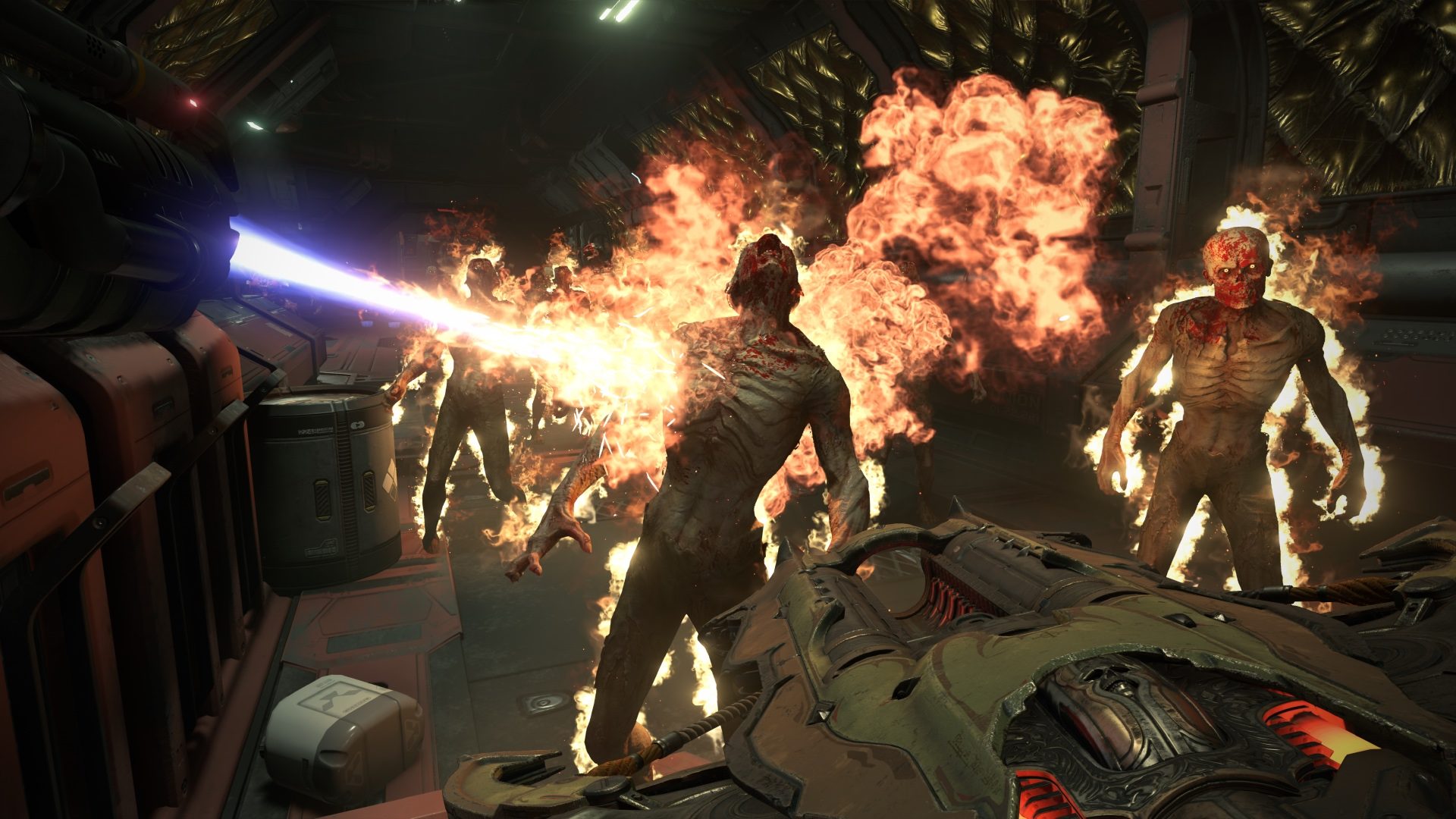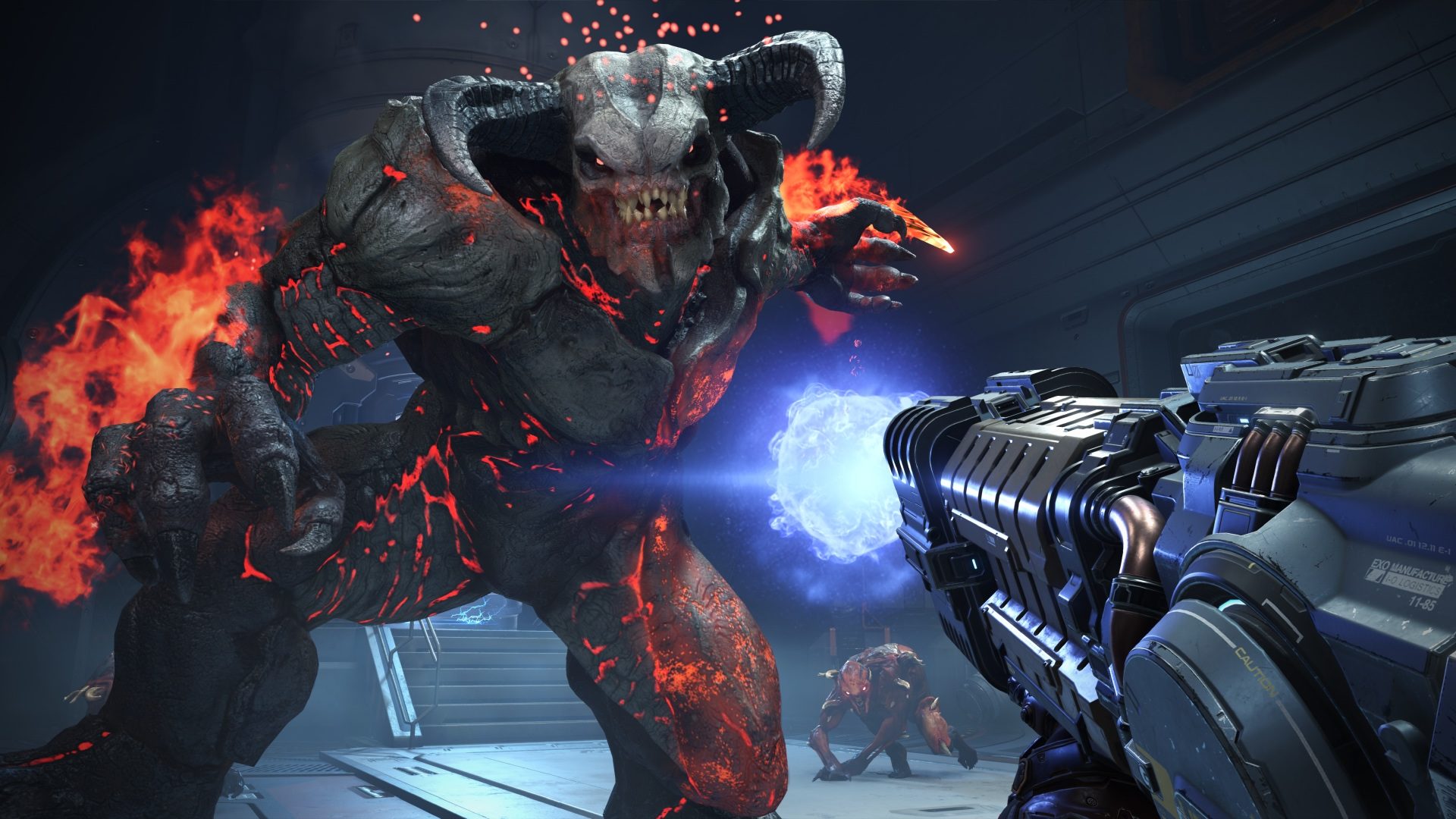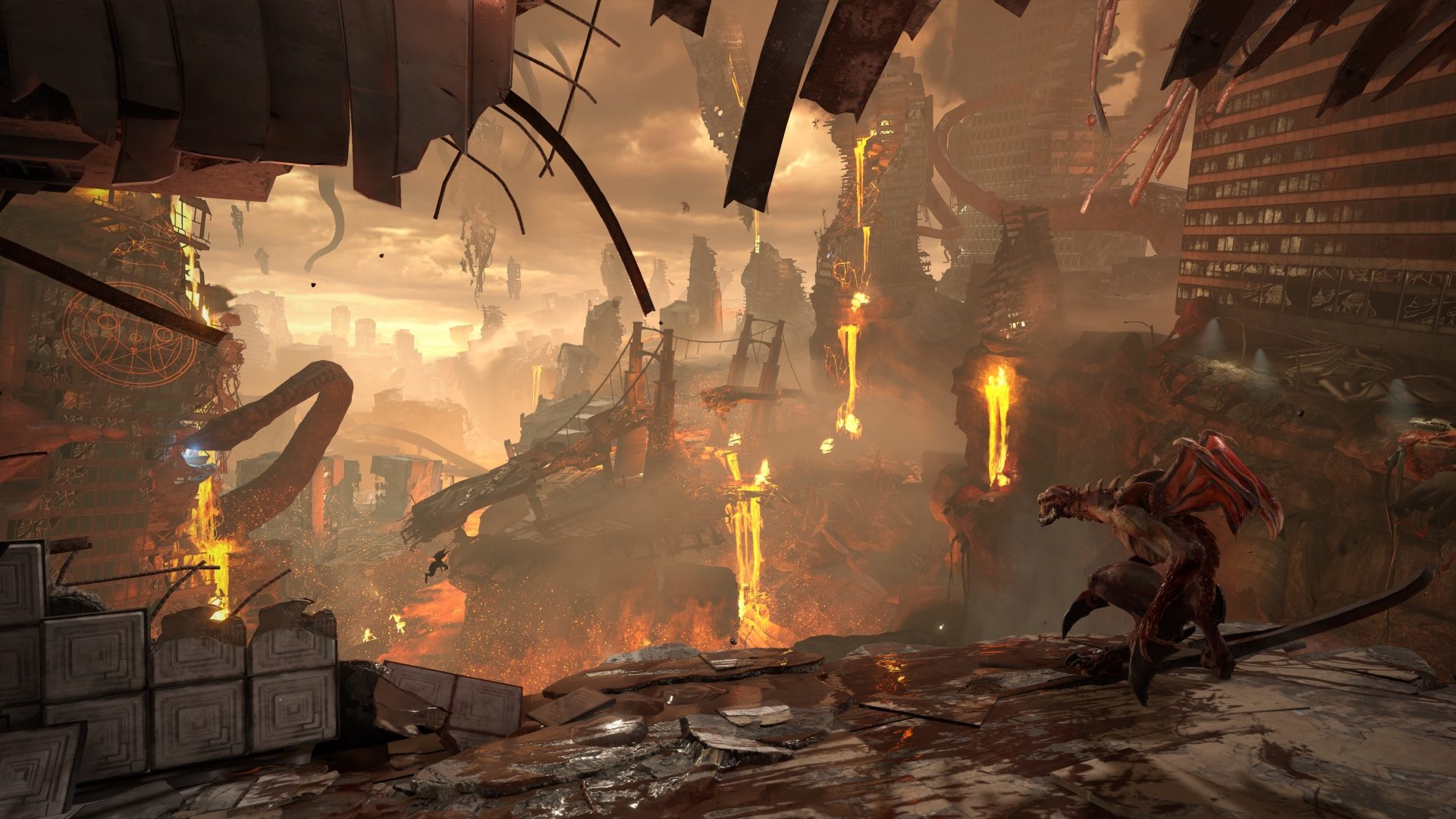Doom Eternal raises an interesting philosophical question. How do you make a sequel—which is traditionally supposed to be “bigger” and “more”—to a game which made such an impression by being the opposite of that? Doom 2016’s biggest selling point was its iconoclastic and reactionary approach to its own genre. Mechanically, it was sparse, but that made it feel immediate, and the glory kill system encouraged constant movement and circulation as opposed to other modern shooters’ predilection for cowering behind cover and regenerating health. Pair that with a devilishly over-the-top technometal soundtrack and you had, in my mind, a perfect game.
As far as expanding on its predecessor’s design and mechanics, Doom Eternal certainly does that. You’re still running around large arenas, glory-killing demons, and occasionally having to do annoying platforming segments, but you’re also burning enemies for armor, double-dashing out of danger, and switching between two different kinds of grenades, all in the span of about 30 seconds.
But whether or not these additions to Doom 2016’s winning formula actually improve the experience in Doom Eternal is a much harder question to answer. The best visual metaphor for the difference between id Software’s revelatory Doom reboot from 2016 and that reboot’s sequel, Doom Eternal, can be found when comparing each game’s HUD.
Here’s Doom 2016’s HUD:

And here’s Doom Eternal’s HUD:

Controlling Doom Guy (who’s now known exclusively as the metal-appropriate “Slayer”) in Doom felt like controlling a person, albeit a highly resilient person with a penchant for shotguns who was stuck between Hell and a hard place. Controlling the Slayer in Doom Eternal feels almost like controlling an agile, miniaturized mech. There are so many levers to pull and knobs to twist, so much micromanaging in the face of the apocalypse, that it becomes sometimes easy to feel disconnected from the actual fight.
Theoretically, the Slayer’s new and modified tools should make the action in Doom Eternal even more aggressive and immediate. His shoulder-mounted flamethrower, which causes enemies to drop small amounts of armor, gives you even more ways to stay in the fight. The now-rechargeable chainsaw (up to one use, though you’ll still need more fuel in the tank if you want to take out bigger enemies), which you have at your disposal with the press of a button, means that you can almost always get ammo whenever you need it. The new freeze grenade not only immobilizes whatever enemies you hit but can also be upgraded to provide you with another option for getting health back in a pinch. And the Blood Punch can quickly vaporize or stun (depending on the size of the enemy) swaths of demons.
But, in some ways, the wealth of options creates the opposite of its intended effect. You’re still not regenerating health, but you are sometimes waiting out the storm while your flamethrower or chainsaw recharge. Avoidance, not engagement, can at times be the optimal strategy, and that’s counter to the Doom philosophy, at least as we now know it.

In other words, while these additions might seem like an expansion of the previous game’s core philosophy, the reality is that it’s just more complicated. Sometimes this can be a good thing. Getting in a flow state where you’re instinctively burning, sawing, and crushing the collective skulls of the demon horde can feel amazing when the carnage goes your way. It doesn’t hurt that, at least on the Xbox One X, Doom Eternal runs like a dream, with nary a frame drop or performance hiccup in sight.
Elsewhere in Doom Eternal’s design, however, this tendency towards complication can inhibit momentum, specifically when it comes to your enemies. One of the coolest things about Doom Eternal is how its visual gore telegraphs how close to death your enemies are. Hitting bigger enemies like the Arachnotron or the Mancubus will (rip and) tear off meaty chunks of their bodies, so that by the time you’re done with them, they look like anatomical cross sections from Hell’s science textbooks. The more flesh that’s missing, the closer they are to death.
But Doom Eternal takes this a step further by also including specific weak points on enemies and specific ways to best take out these weak points. You can, for example, shoot out both of a Revenant’s shoulder-mounted cannons, which forces them to come at you arms flailing. Same goes for the Archnotron’s rear-mounted gun or the Mancubus’s arms. Again, on paper, this should help to make combat more dynamic, but the ways in which the game suggests you take out these weak points is by using one particular gun’s zoomed-in sniper mod. Other demons, like Pinkies or Hell Knights, are listed as having weaknesses to the chaingun, while those who use shields are particularly vulnerable to the plasma cannon. It’s a more intentional design, sure, but that doesn’t automatically mean it’s better. Constantly swapping from weapon to weapon and slowing down time in the heat of an intense fight can provide for some hilarious, hectic, and cinematic moments, but it can also hamper your momentum. More nefariously, it can limit the way you want to play. The last thing I want to do in Doom is snipe, but I ended up doing that a lot throughout my time with the game.
The new dash move has a similarly unintended side effect when added to Doom’s gameplay. Being able to dash forward at enemies might make it seem like the game is encouraging aggression, but what it means in practical terms is that the enemies are even more accurate, their area-of-effect attacks are annoyingly further-reaching, and the buzzkilling platforming segments are even more prevalent. Again, dashing out of danger can be fun, but it’s yet another button for you to have to manage. It fixes a problem that Doom 2016 didn’t have.

All of this is not to say that Doom Eternal’s gameplay is somehow bad now, because it’s not. It still retains that nugget of visceral genius that made Doom 2016 so memorable. Floating and stinging like a space marine Muhammad Ali in Doom Eternal’s combat arenas is still satisfying and chunky, even if some of those arenas are a little more narrow and awkward than they were in the previous game. Going purely on its core mechanics, Doom Eternal is still the most satisfying single-player shooter experience I can think of—outside of its predecessor. It’s just that the overcomplication of its mechanics giveth and taketh away in equal measure. As another demon slayer, Trevor Belmont, recently said, “I’m a simple man with simple pleasures.”
There’s a moment in Doom Eternal’s 15-or-so-hour campaign that, I think, could have proved an interesting gameplay direction for the sequel. In it, the Slayer mindmelds with a Revenant to retrieve his Super Shotgun from a particularly hard-to-reach area. It’s not the first time that players got to control a demon, as both Doom 2016’s and Doom Eternal’s multiplayer modes (the latter of which is still unplayable at the time of this review) put players in the role of Hell’s best and brightest. But it is the first time that players can control a demon within the context of Doom’s campaign, and it provides an interesting remix on the gameplay while also asking some interesting questions about the nature of the Slayer. More of these moments could have provided an refreshing direction for the single-player, but we unfortunately only get a small glimpse at what it’s like to kill demons with other demons.
An unexpected area of the game where complication turned out to be a good thing is in the game’s lore. I never thought I would say this, but I actually took time out of gibbing demons to read the extensive text-based backstory that Doom Eternal provides through its collectibles. That’s not a knock against the gameplay but rather a commendation of the game’s story. I found myself thoroughly enjoying the background given on the Slayer, the Makyrs, Argent D’Nur, and the Night Sentinels. This context to the carnage propelled me through the campaign in a way that Doom 2016’s story never really did, and it’s something that I wouldn’t mind seeing further explored in, say, a Netflix-produced animated show. The story isn’t perfect, and having yet another villain whose species’ survival relies on the subjugation of another species isn’t all that compelling (sorry, but Thanos is not interesting just because he has a motivation), but the Slayer’s background definitely gives his wordless bloodlust a heavier quality.
The other aspects of Doom Eternal that propelled me forward was the intricate art design and the soundtrack. While the game spends maybe a little too much time on Earth, the segments that take place outside of our woefully mundane dimension ooze with style. If the Hell segments in Doom 2016 tickled your fancy, there’s one level in particular that is a Boschian nightmare in the best sense of the phrase. And trust me, you’re going to want to play this game with headphones, because listening to the soundtrack through TV speakers doesn’t do it justice.
Doom Eternal was always going to have a tough time bettering the formula laid out by its predecessor, and like another sequel I recently reviewed, Doom Eternal’s mantra seems to be that “more is better,” even when that runs counter to what made Doom 2016 so enjoyable. At least it doesn’t stray too far from the magic formula, but given how much I adored Doom 2016, I find myself feeling surprisingly ambivalent towards its follow-up. Still, as long as I have a head to bang and demons to kill, I’m going to emerge from Hell happy.

All images: Bethesda Softworks
|
★★★★☆
As long as Doom Eternal didn’t stray too far from its predecessor, it was going to be a good game. But id Software comes surprisingly close to muddying everything with new mechanics. The flamethrower and rechargeable chainsaw give you more options during battle, but they can also feel like unnecessary additions. Still, a deeper lore, a banging soundtrack, and plenty of demons to gib leave Doom Eternal in a happy place—relatively speaking. |
Developer id Software Publisher Bethesda Softworks ESRB M - Mature Release Date 03.20.2020 |
| Doom Eternal is available on Xbox One, PS4, Switch, and PC. Primary version played was for Xbox One. Product was provided by Bethesda Softworks for the benefit of this coverage. EGM reviews on a scale of one to five stars. | |

Michael Goroff has written and edited for EGM since 2017. You can follow him on Twitter @gogogoroff.